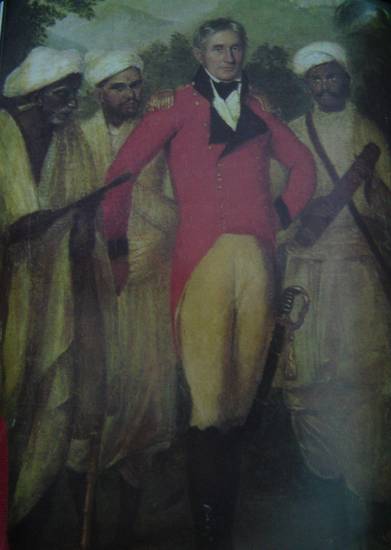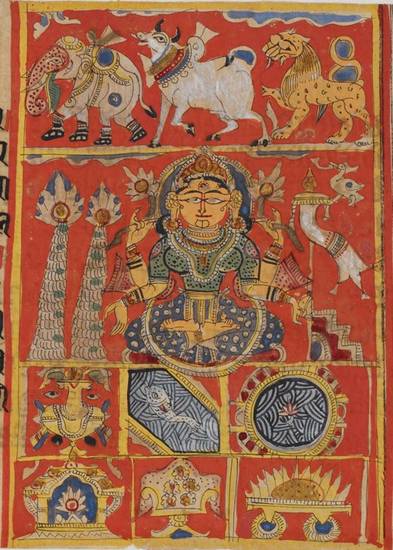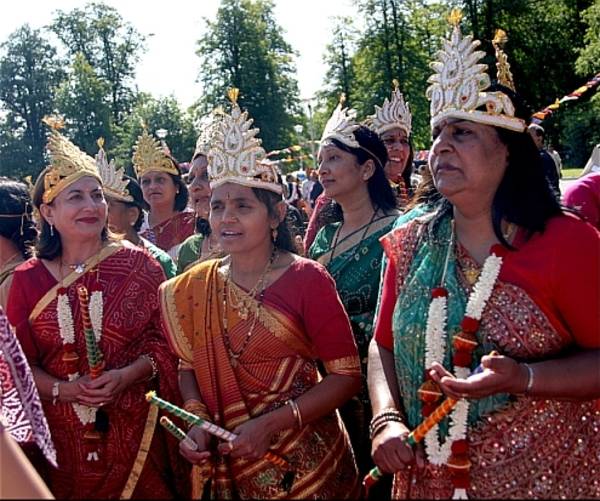Article: Studying Jainism
Early contact between Jains and Western visitors to India in the early 16th century gradually led to a more scholarly approach to the Jain faith on the part of many Westerners. The academic study of Jainism was born at the end of the 19th century. Since then it has developed in many different ways in several places, both in India and outside. More and more scholars in India and the West are joining this relatively new field of academic research. Beginning with textual and linguistic approaches to Jain holy writings, the study of Jainism in Western universities has branched out more recently into fields such as art, sociology and anthropology.
Research into and study of Jainism in India has also grown, with the establishment of research centres and universities dedicated to Jain studies. The attitudes of the various sects differ regarding education in religious studies but both lay and mendicant Jains are increasingly undertaking formal study of Jainism within the university system.
Seminars and conferences discussing Jain studies – for which some people use the term ‘Jainology’ – are becoming more frequent. Books and online resources on Jain studies are also on the rise. In Western countries where significant Jain communities live, there is ever-greater interest in the study of Jainism, resulting in various activities. The JAINpedia website and project is one outcome of this trend. Jain studies may be represented by a handful of scholars in each country outside India, but they form an active minority.
Western discovery of the Jains
Meetings in India between Western visitors and Jains were recorded from the early 16th century. Europeans who visited the subcontinent to carry out business or to evangelise Christianity sometimes met Jains, whom they initially found almost impossible to understand. A fascination with the most visible differences from their own customs is the hallmark of European records of these encounters.
As Europeans became more familiar with India over the following centuries, they often documented in great detail what they noticed about the people and places they met. They were strongly struck by the holy places of Jainism and centres of pilgrimage, especially the colossal statue of Bāhubali at Shravana Belgola and the huge temple-city of Shatrunjaya. However, close contact with Jains, their scriptures and their religious practices took place chiefly in the context of the European colonisation of India, especially British India. Western merchants, missionaries, scholars, soldiers and civil servants built up their knowledge of what they found in India in large part from their encounters with local people. This was probably the most decisive factor in the Europeans’ dawning recognition of the unique nature of the Jain faith.
First encounters with Jains – intriguing people
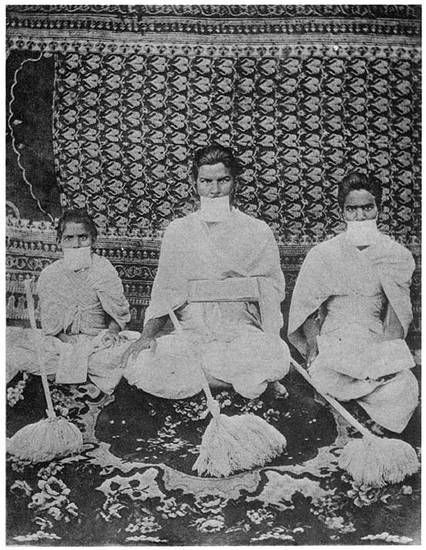
Three Śvetāmbara Sthānaka-vāsin monks
Image by R. V. Russell and Rai Bahadur Hira Lāl © public domain
The first meetings between Jains and European visitors to India produced deep cultural shock in the latter. The visible signs of the Jain faith – people and places – struck foreigners very strongly but at that time there was still no place for something called ‘Jainism’ – a doctrine and tradition, a set of principles.
The main early evidence of Europeans coming into contact with Jains in India dates back to the 16th to 17th centuries. The Europeans were Portuguese, Dutch, British, Italians or French who travelled to the western Indian coast or to southern India for trading or missionary purposes. Those travelling in western India came face to face with people whom they often called ‘Baniyans’ or merchants. In their parlance, this means Jains.
Occasionally the Europeans came across people they called ‘Vartia’ or ‘Vertea’. This term is an approximate rendering of the Indian word vratya – roughly ‘those who take vows’ – and refers to Jain monks. These travellers often mentioned that the Jains wore mouth-masks or mouth-cloths and carried cotton brooms to avoid killing insects. Recurring features in the travellers’ accounts are the muṃhpatti and the rajoharaṇa, along with the plucking out of the hair, prohibition on eating at night and fasting unto death. Records of these encounters show that the travellers were rather puzzled and embarrassed.
In some cases, they went into more detail about what they observed. For example, a Scots sea captain named Alexander Hamilton described the monastic equipment of Śvetāmbara ascetics rather precisely. Henry Lord, an Anglican chaplain, is the first to name some Jain monastic groups, the Tapā-gaccha and the Kharatara-gaccha, as well as the festival of Paryuṣaṇ – ‘Putcheson’ as he called it. The Anglican clergyman John Ovington wrote A Journey to Surat in the year 1689. Here he went a step further than his fellow British travellers, supplementing his descriptions of Jain behaviour with explanations he must have got from oral informants.
In south India, the Jesuit Father Roberto de Nobili, the founder of the Madurai mission in 1606, gave an account of the troubled relations between Jains and Śaivas in the Tamil country. This is based on a Jain text, although he uses the label ‘Buddhist tradition’. In the 18th century the Jesuit Beschi and the Protestant Ziegenbalg intuited the important place held by Jains in the religious history and culture of south India. Jesuit missionaries coming from France in the 18th century, such as Father Coeurdoux or Abbé Dubois, also drew on Jain accounts of their own history. See Williams 1977 and Orr 2009 for more about these and other early contacts between Jains and Western Europeans.
Most observers, especially in western India, were struck by the appearance of Jain ascetics and by behaviours showing such profound respect for life – ahiṃsā – that they found it beyond understanding. The utter foreignness of what they observed meant they did not know how to assess what they saw or what to think about it. This is why they largely remained at the surface, describing only the visible signs of practices that were totally alien to their intellectual framework. To some extent, the part played by Jains in south India seems to have been realised in a better way and earlier.
Encounters with places and monuments – uncommon artistic achievements
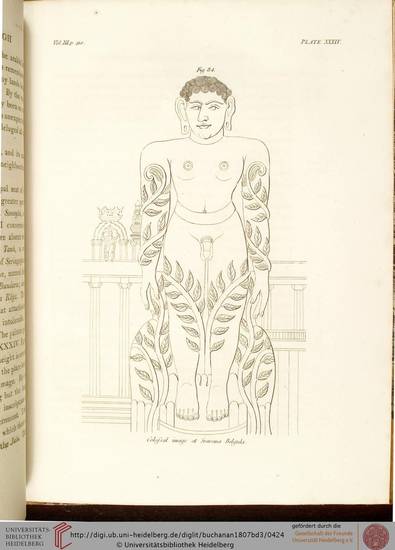
Buchanan’s sketch of Bāhubali
Image by © Heidelberg University Library
During the British control of India, imperial civil servants frequently travelled and conducted investigations of Indian life, mainly for administrative purposes. These led them to discover visible traces of Indian culture, to which the Jain tradition belongs, whether or not they were able to identify them as Jain.
The colossal Digambara statues of Bāhubali at Shravana Belgola and Karkala were among those which struck Colin Mackenzie (1753–1821) and Francis Buchanan (1762–1829). These two men were among the first and most significant Europeans to discover the rich heritage of Jainism in south India, especially Karnataka (Orr 2009 and Howes 2010).
On the other hand, Jain monuments in western India were deliberately reviewed and described by British archaeologists, such as James Burgess and Henry Cousens. Regional branches of the Archaeological Survey of India carried out systematic tours cataloguing items of interest during the 19th century, including the famous temple-city of Mount Shatrunjaya.
The English botanical artist Marianne North is one of several widely travelled individuals who produced sketches or paintings of Jain monuments without necessarily knowing exactly what they were.
Encounters with people – a decisive factor
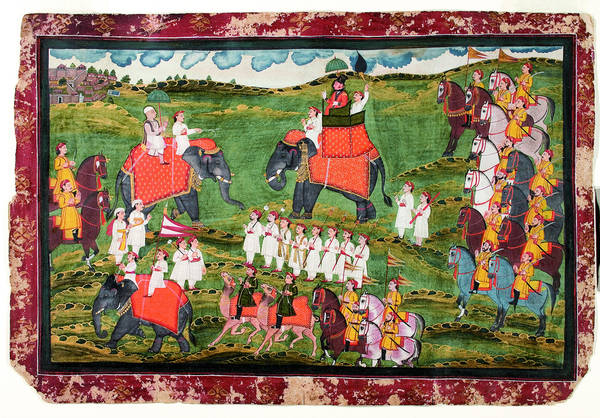
Captain James Tod mounted on an elephant
Image by San Diego Museum of Art © public domain; Edwin Binney 3rd Collection
Encounters with living Jains, who had direct access to their tradition, have been decisive factors in helping Europeans understand that there is a specific Jain identity. These encounters mostly took place within an official context. British officers posted in India from the 18th century onwards had Indian informants and assistants for the various tasks they had to fulfil. Scholars of south Asian cultures also met Jains while researching their work.
The 18th-century French Jesuit Abbé Dubois is considered ‘the first missionary who came into personal contact with a member of South India’s Jain community’ (Orr 2009: 267).
Posted to south India, Francis Whyte Ellis (1777–1819) was in direct contact with the chief guru of Shravana Belgola in Karnataka.
In Calcutta at the beginning of the 19th century, Henry Thomas Colebrooke was in close contact with a member of the prominent Jagatseth family, Jains who later turned Vaiṣṇavas. The Jagatseth connection was the main source of the Jain manuscripts that later formed the Colebroke collection at the India Office Library, now part of the British Library.
In 1802 the Scottish soldier Alexander Walker was appointed the first political resident at the court of Baroda in Gujarat and wrote Narratives of the Mahrattah History and an Account of the Jeyn or Shravacca Religion. In this book he refers to information from members of the Śvetāmbara monastic community. He shows sympathy towards the Jains and a rather intimate knowledge of the Gujarati Jains of his time. In his still unpublished work (see Luithle-Hardenberg, forthcoming), he also rightly insists on differentiating the Jain religion from the ‘Hindoo faith’.
European scholars who travelled in western India during the 19th century refer to various Śvetāmbara mendicants as having introduced them to temple-libraries or having informed them about the past and present of Jains in the region. An example is James Tod, who travelled in Gujarat and Rajasthan between 1819 and 1823 and mentions Yati Jñānacandra from the Kharatara-gaccha monastic order.
In this period individual Jains were important contacts for Westerners in India, either as assistants to scholars and administrators, or as sources of information.
Among the assistants in South India to Colin Mackenzie, Surveyor General of India from 1784 to 1821, was a Jain physician called Durmiah and, later, his son. They were instrumental in deciphering inscriptions, providing information about their faith’s past and present and introducing the right people.
When the search for Jain manuscripts was organised systematically in western India in the 19th century, Jain individuals played an important role. One such case is that of Bhagavandas Kevaldas (1850–1900). He was employed by the Department of Education of the Bombay Presidency for tours undertaken in search of Jain manuscripts all over Gujarat and Rajasthan during the 1880s. As a learned Jain from Surat, he had several helpful connections with local owners. Not only did he work officially for the Bombay Presidency, but he also helped individual scholars and libraries in Europe to buy manuscripts.
‘Jainism’ established as a specific tradition
Discovery of texts and monuments, encounters with people and manuscripts slowly paved the way to the recognition of Jainism as a tradition distinct both from Hinduism and Buddhism. The 1809 contributions by Mackenzie and Colebrooke to Asiatick Researches are still hesitant in this respect. To some extent, they recognise the differences from Hinduism, but Buddhism is more problematic. Jainism and Buddhism were clearly distinguished by Hermann Jacobi seventy years later.
In the 1879 introduction to his edition of the Kalpa-sūtra, Jacobi shows that, though Jainism shares features with Buddhism, it is neither identical nor an offshoot. Instead, it is a tradition that evolved independently in the same geographical area of eastern India at around the same period, in the 6th to 5th centuries BCE.
The distinction between these two religions had been prepared and was continued by the works of another master of Indology and Jain studies, Albrecht Weber, who:
- in 1865 to 1866 published part of the Bhagavatī-sūtra, which forms the fifth Aṅga of the Śvetāmbara canonical scriptures, and is one of the richest in content
- in 1883 to 1885 published a detailed description of the sacred works of the Jains, which was entirely based on the manuscripts collected for the Berlin Royal Library in the 1870s.
The Jainism that Western scholars discovered belongs to the Śvetāmbara Mūrti-pūjaka tradition rather than to the other main sect of the Digambaras. This is explained partly by the fact that Śvetāmbara Mūrti-pūjaka Jains were more visible in the Indian society of that time. Digambaras, especially, were rather a suppressed minority during British rule. A notable exception to this concentration on Śvetāmbara Mūrti-pūjaka sects was the first Surveyor General of India, Colin Mackenzie. He focused on south India and collected a lot of material, as yet partly unexplored, on the Tamil tradition of Jainism.
Trends in Jain studies
At the end of the 19th century the Jain tradition’s distinctive nature was established by textual study. Transmitted through manuscripts, holy texts demonstrated Jain uniqueness to researchers more than investigations of contemporary Jains. Jains did not figure prominently in Indian society at the time, although observations of contemporary Jain practices did exist. The wealth of written matter and the low profile of Jains in 19th-century India explain, at least partly, why textual studies were the focus of scholarly efforts for a long time. It is an exaggeration to state that the philologists of the 19th and 20th centuries concentrated only on the past, ignoring living Jainism. It is true that the first Western studies dealt with the early scriptures, especially those of the Śvetāmbaras. However, the languages of these scriptures are varieties of Prakrits that had to be explored at the same time as the contents of the texts, as both were equally unknown in the West. Hence editions, translations and linguistic analyses were academics’ main activities.
It has often been remarked that serious work on Jain scriptures in the West did not necessarily go with sympathy for their contents or liking of their style. Indeed, judgmental comments minimising or disparaging the contribution of Jainism to world faiths, especially when compared to Buddhism, have been made quite frequently. Today they are shocking or simply out of place. But this was not the attitude of all scholars. Those who had contact with living Jains and observed them carefully often realised the originality and intellectual interest of their views on the world.
Today, textual studies have diversified, concentrating as much on later scriptures as on the early tradition and including literature in vernacular languages. This has led to scholarly activities in the following areas:
- Jain philosophical works, in Sanskrit
- dialogue between Jain and Buddhist thought
- inter-sectarian debates
- Jain narrative literature.
Coming from religious traditions that share features of origin and early development, Jain and Buddhist thinkers have had a sometimes uneasy relationship. The differences and similarities of the two faiths were particularly explored in the 5th to 12th centuries CE in texts written by leading mendicants of both religions.
Studies of different sects’ approaches to certain issues have shown that Jainism is not a monolithic block. Like any developing and living faith, it has given birth to various currents and groups, who differ over matters of ideas and practices. The position of women and the practice of nudity are examples of divisive issues that have been the subject of centuries-old debates.
The importance of Jain stories had been recognised by the scholars of the late 19th and early 20th centuries. Stories are a fundamental component of Jain teaching. Jain mendicants have written many and have contributed to the pan-Indian repertoire.
Since the 1980s ethnographic and anthropological studies have developed extensively and given a new angle to the scholarly examination of Jainism. The study of Jain art is a more recent trend, with more significant exhibitions held, especially outside India. Examples include major shows in Los Angeles and London during 1994 and 1995, Antwerp in 2000 and New York in 2009.
In general more work has been done on the Śvetāmbara tradition than on the Digambara. This deficit on the Digambara side is being remedied as more scholars these days turn to this rather neglected area.
Investigations of a rather technical character and handbooks or collections that aim at a wider audience can be easily distinguished. The latter aim to make Jains and Jainism accessible to as many people as possible.
Textual studies
Scholarly examination of Jain texts can be divided into several groups, according to the approach taken.
|
Types of studies |
Jain texts |
Leading scholars |
|---|---|---|
|
editions and critical editions of Jain scriptures |
|
|
|
descriptions and translations |
Śvetāmbara canon |
|
|
historical formation of and distinction between various textual layers |
|
|
|
investigation of various layers of commentary |
Jain commentaries on the canon |
|
|
discovery of major narrative works in Prakrit reflecting the earlier stage of narrative literature |
|
|
|
translations of major narrative works |
Hemacandra’s standard books on Jain Universal History:
|
|
|
translations and studies centring on major scriptures |
|
|
|
investigation of debates among different monastic orders |
|
Language studies
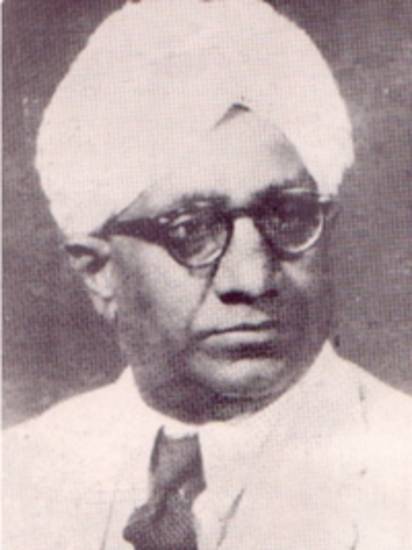
A. N. Upadhye
Image by unknown © unknown
Many Jain scriptures, especially those dating back to the early period, are written in various forms of Prakrits, not in Sanskrit. The foundation study for these languages is Richard Pischel’s 1900 Grammatik der Prakrit Sprachen (Grammar of the Prakrit Languages), later translated into English and Hindi.
Texts produced by the Digambara sect are associated with the later form of Prakrit called Apabhraṃśa. Some Apabhraṃśa Prakrit works were edited in Europe between 1918 and 1937 by Hermann Jacobi and Ludwig Alsdorf. But later on, all the editions and tools were produced in India, especially by A. N. Upadhye and Hiralal Jain. Beginning in the 1970s, Western academics in France and Belgium – at the University of Ghent – have again turned to this rewarding area of study. They have worked on Digambara authors such as Yogīndu and on the Apabhraṃśa versions of the Rāmāyaṇa.
Although overwhelming in quantity, the rich Śvetāmbara Jain literature in Old Gujarati has almost exclusively been the focus of interest of Indian scholars, whether monks or lay people. They are usually native to the region and have first-hand knowledge of the language. Western scholars are exceptions in this area thus far.
Studies of Jain art
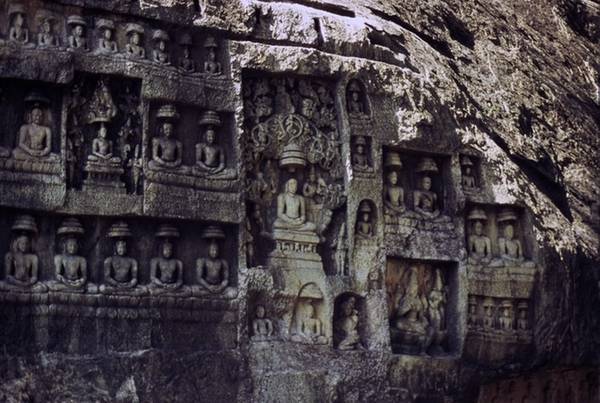
Carvings of Jinas
Image by Jennifer Howes © CC BY-NC 3.0
The scholarly study of Jain art is a relatively new field and mainly falls into the two areas of:
- temple architecture
- manuscript painting of western and central India.
There are hundreds of Jain temples in India and they are often distinctively Jain in terms of their style and architecture. However, Jain temples display enormous variation too, demonstrating technical development over the centuries and incorporating local styles and materials. Significant examples of Jain temples that have inspired academic exploration include:
- cave temples, with famous examples at Ellora and Badami
- the important temple complexes of central India such as Khajuraho and Deogarh
- the temple-cities of Shatrunjaya and Girnar
- the impressive temples at Mount Abu and Ranakpur.
Paintings in manuscripts have always been one of the main ways of transmitting religious knowledge among Jain communities. Prominent work in this field of study has been completed by Indian scholars who had direct access to the material preserved in temple-libraries, such as Muni Puṇya-vijaya, U. P. Shah, Moti Chandra and Saryu Doshi. But the three books published in the 1930s by the American scholar W. Norman Brown remain the essential reference works on manuscript illustrations of the three major texts of the:
- Kalpa-sūtra
- Story of Kālaka
- Uttarādhyayana-sūtra.
Development of this trend in Jain studies has been favoured by important events among the Jain community. Examples include the celebration of the 2,500th anniversary of the final liberation of Mahāvīra, the 24th Jina in 1974 and the thousandth anniversary of the consecration of the colossal Bāhubali statue at Shravana Belgola in 1981. These events have created an increased awareness of the richness of Jain heritage, and have been the starting point of art books published in India.
Initially, there tended to be many more studies of the Jain art of western and northern India than of south India. More recently, this has been balanced by various projects such as:
- Jain Art in Karnataka – J.A.B. Hegewald, 2010
- Jaina temples of Tamil Nadu – a project of the French Institute of Pondicherry led by N. Balbir, K. Ladrech, N. Murugesan and Ramesh Kumar – which will be published as a CD-ROM.
Sociological, ethnographic and anthropological studies
This trend in Jain studies has developed considerably since the late 1970s under the impulse of scholars working in the United Kingdom and North America. Though ethnographic studies of the Jains produced in continental Europe do exist and are valuable, they are rarer. This is changing these days, as the overall focus of Jain studies shifts from philological and classical studies to modern studies in the general academic context.
|
Topic of study |
Examples of publications |
|---|---|
|
food habits |
Mahias, France, 1985 |
|
Jain lay life including interaction with mendicants, worship, festivals and calendar |
|
|
Jain diaspora in the UK |
Banks, 1994 |
|
women, including literary images, the place of women in rituals and daily religious life |
|
Handbooks published outside India
The first two significant syntheses on Jainism were written in German in 1925 and in French the following year. Naturally, they have to be read against more recent works, but they still contain valuable material and information, giving an overview of what was known at that time.
Since the late 1970s key reference books have been published in English, namely:
- Jaini – The Jaina Path of Purification in 1979
- Dundas – The Jains in 1992, the second edition in 2002
- Wiley – Historical Dictionary of Jainism in 2004.
It is often said that Padmanabh S. Jaini’s The Jaina Path of Purification marked a turning point in the field, so that scholars talk of a pre-Jaini and post-Jaini period of Jain studies. In particular, Jaini’s book gives much more attention to Digambara sources and viewpoints than ever before in general syntheses on Jainism.
Story collections
Jain story literature has been written in all the languages Jains have used, from Prakrit and Sanskrit and vernacular languages. The rich heritage of the traditional tales is a path often considered more accessible to a wider audience than the doctrinal scriptures themselves. Indeed, stories are a means of teaching that has always been believed essential by Jains themselves, as they provide examples to follow or not to imitate.
Major anthologies of Jain stories have been published since the 1960s, including:
- Granoff – The Clever Adulteress 1991 and The Forest Thieves 1998
- Mette – Die Erlösungslehre der Jaina – Legenden, Parabeln, Erzählungen, 2010 (Jaina Soteriology: Legends, Parables and Narratives)
Reading
- ‘An Early Nineteenth Century Study of the Jains’
Ernest Bender - Journal of the American Oriental Society
volume 96: 1
American Oriental Society; New Haven, Connecticut USA; 1976
- ‘Jainology in Western Publications I’
Klaus Bruhn - Jain Studies in Honour of Jozef Deleu
edited by Rudy Smet and Kenji Watanabe
Hon-no-Tomosha; Tokyo, Japan; 1993
- ‘The Study of Jaina Art’
Klaus Bruhn - Jain Studies in Honour of Jozef Deleu
edited by Rudy Smet and Kenji Watanabe
Hon-no-Tomosha; Tokyo, Japan; 1993
- ‘Observations on the sect of Jains’
Henry Thomas Colebrooke - Asiatic Researches
volume 9
1807
- Jains in the World: Religious Values and Ideology in India
John E. Cort - Oxford University Press USA; New York, USA; 2001
- The Jains
Paul Dundas - Library of Religious Beliefs and Practices series; series editor John Hinnels and Ninian Smart; volume 14
Routledge Curzon Press; London, UK; 2002
- History, Scripture and Controversy in a Medieval Jain Sect
Paul Dundas - Routledge Advances in Jaina Studies series; series editor Peter Flügel; volume 2
Routledge Curzon Press; London, UK; 2007
- ‘The Invention of Jainism: A Short History of Jaina Studies’
Peter Flügel - Journal of Jain Studies
volume 11
Kyoto, Japan; 2005
- Scripture and Community: Collected Essays on the Jains
Kendall W. Folkert - edited by John E. Cort
Studies in World Religions series; volume 6
Center for the Study of World Religions, Harvard University & Scholars Press; Atlanta, Georgia, USA; 1993
- Victorious Ones: Jain Images of Perfection
Phyllis Granoff - Mapin Publishing Pvt. Ltd and Rubin Museum of Art, New York; Ahmedabad, Gujarat, India and New York, USA; 2009
- The Jaina Path of Purification
Padmanabh S. Jaini - University of California Press; Berkeley, California USA; 1979
- Gender and Salvation: Jaina Debates on the Spiritual Liberation of Women
Padmanabh S. Jaini - University of California Press; Berkeley, California, USA; 1991
- Co-operation and Competition, Conflict and Contribution: The Jaina Community, British Rule and Occidental Scholarship from the 18th to the Early 20th Century
Andrea Luithle-Hardenberg - Studies in Asian Art and Culture series
EB Berlag; Berlin, Germany; 2013
- ‘The Mackenzie Parsvanath at the V&A: Research in Progress on the British Library’s Mackenzie Collection’
Jennifer Howes - South Asia Archive & Library Group Newsletter
volume 2
British Library; London, UK; November 2004
- Illustrating India: The Early Colonial Investigations of Colin Mackenzie (1784–1821)
Jennifer Howes - Oxford University Press; Oxford, UK; 2010
- Die Erlösungslehre der Jaina: Legenden, Parabeln, Erzählungen
- translated and edited by Adelheid Mette
Insel Verlag; Berlin, Germany; 2010
- Gujarati School and Jaina Manuscript Paintings
Ratan Parimoo - N. C. Mehta Collection series; volume 1
Gujarat Museum Society; Ahmedabad, Gujarat, India; 2010
- Jainism and Early Buddhism in the Indian Cultural Context: Essays in Honor of Padmanabh S. Jaini
Olle Qvarnström - Asian Humanities Press; Fremont, California, USA; 2003
- ‘Orientalists, Missionaries, and Jains: The South Indian History’
Leslie C. Orr - The Madras School of Orientalism: Producing Knowledge in Colonial South India
edited by Thomas R. Trautmann
Oxford University Press; New Delhi, India; 2009
- A census of Indic manuscripts in the United States and Canada
Horace I. Poleman - American Oriental series; volume 12
American Oriental Society; New Haven, Connecticut, USA; 1938
- The Doctrine of the Jainas: Described after the Old Sources
Walther Schubring - translated by Wolfgang Bühlen
edited by Satya Ranjan Banerjee
Lala Sunder Lal Jain Research series; volume 15
Motilal Banarsidass; New Delhi, India; 2000
- The Heart of Jainism
Margaret Sinclair Stevenson - Munshiram Manoharlal; New Delhi, India; 1984
- Travels in Western India: embracing a visit to the sacred mounts of the Jains and the most celebrated shrines of Hindu faith between Rajpootana and the Indus, with an account of the ancient city of Nehrwalla
James Tod - Munshiram Manoharlal; New Delhi, India; 1997
- The Clever Adulteress and Other Stories: A Treasury of Jain Literature
Phyllis Granoff - Mosaic Press; Oakville, Ontario, Canada; New York, USA; London, UK; 1990
Links
- Francis Buchanan biography
-
This Wikipedia entry profiles Francis Buchanan (1762–1829), who carried out extensive surveys of southern and north-eastern India during the British East India company's expansion into India.
- Colin Mackenzie biography
-
This Wikipedia article on Colin Mackenzie (1753–1821) summarises his career. As the first Surveyor General of India under early British colonial rule, he supervised detailed investigations into Indian architecture, especially in southern India.
- James Tod biography
-
An officer in the British East India Company, James Tod (1782–1835) published extensive accounts of the history and geography of India, including details of his travels in Gujarat and Rajasthan between 1819 and 1823. This entry from volume 56 of the Dictionary of National Biography (1885–1900) appears in Wikisource.
- Henry Cousens – photographing India
-
The Digital South Asia Library at the University of Chicago provides detailed information about some of the trips made from 1889 to 1895 by Henry Cousens (1854–1933) in British India. Accompanied by other members of the Archaeological Survey Department and Indian assistants, Cousens took photographs for survey purposes.
- Jean-Antoine Dubois biography
-
Wikisource provides a profile of Abbé Dubois (1765–1848) from the 1913 Catholic Encyclopedia. Dubois preached Christianity in India for over thirty years and wrote extensively about his experiences.
http://en.wikisource.org/wiki/Catholic_Encyclopedia_%281913%29/Jean-Antoine_Dubois fr
- Francis Whyte Ellis biography
-
A civil servant in the East India Company during the early colonisation of India by the British, Francis Whyte Ellis (1777–1819) became a well-known scholar in the Tamil and Sanskrit languages. This entry from volume 17 of the Dictionary of National Biography (1885–1900) appears in Wikisource.
http://en.wikisource.org/wiki/Ellis,_Francis_Whyte_%28DNB00%29
- Henry Colebrooke biography
-
The life and career of Henry Thomas Colebrooke (1765—1837), a British administrator in India, is summed up in volume 11 of the Dictionary of National Biography, 1885—1900. An accomplished scholar of Sanskrit and of Hindu literature, Colebrooke was one of the founders of the Royal Asiatic Society. His intellectual interests were extremely wide, covering mathematics, science, law, languages and religion.
http://en.wikisource.org/wiki/Colebrooke,_Henry_Thomas_%28DNB00%29
- Alexander Walker biography
-
A Scots-born soldier and administrator in the East India Company, Alexander Walker (1764–1831) was one of the first Westerners to distinguish between Jains and Hindus. His son donated his collection of Arabic, Persian and Sanskrit manuscripts to the Bodleian Library in Oxford. This entry from volume 59 of the Dictionary of National Biography (1885–1900) appears in Wikisource.
- British Library – India Office records and private papers
-
The records of the defunct India Office are in the collections of the British Library. The India Office held the official archives of the:
- East India Company (1600–1858)
- Board of Control or Board of Commissioners for the Affairs of India (1784–1858)
- the India Office (1937–1947)
- and the Burma Office (1937–1948).
There is also material from other parts of Asia, the Middle East and parts of Africa, plus personal papers from British India.
http://www.bl.uk/reshelp/findhelpregion/asia/india/indiaofficerecords/indiaofficehub/
- Bhogilal Leherchand Institute of Indology
-
The Bhogilal Leherchand Institute of Indology in New Delhi focuses on scholarly research into Śvetāmbara Jainism. With a library of manuscripts for research, it organises academic seminars and publishes scholarly books.
- Institut Français de Pondichéry
-
The French Institute of Pondicherry is a research centre of the French Ministry of Foreigh Affairs. Founded in 1955, it undertakes scholarly research and training in South and South-East Asia. The website is in English.
- Jaina temples of Tamil Nadu
-
A scholarly project researching the Jain temples of Tamil Nadu, investigating worship rituals and celebrations in addition to the architecture, art and inscriptions of the buildings. Led by the French Institute of Pondicherry, the project will be published as a CD-ROM.
- Archaeological Survey of India – history
-
The Archaeological Survey of India was set up in 1784 by Sir William Jones in Calcutta. It began publishing the Asiatick Researches journal in 1788, which publicised the results of surveys of historical sites and monuments in India.
- Indian universities with departments of Jain studies
-
Jainworld provides a list of Indian universities that have departments with researchers in or courses investigating aspects of Jainism.
- Jain research institutions in India
-
Jainworld provides a list of research institutions in India that focus on various aspects of Jainism.
- Mahavir Aradhana Kendra – institute
-
Based around the pilgrimage site of Mahaviralaya – a temple dedicated to Mahāvīra, the last Jina – Mahavir Aradhana Kendra is a manuscript library and research institute, which publishes academic books, chiefly on Śvetāmbara Jainism. There is also a museum that includes the monastic equipment used by Gacchādhipati Ācārya Śrī Kailāsaāgara-sūrīśvara Mahārāj.
- Marianne North biography
-
This page on Answers.com gives detailed information about the life and career of Marianne North (1830–1890). A British painter famous for lifelike paintings of plants and flowers, North also painted landscapes during 13 years of global travel, spending 1877 to 1878 in India.
- Jain Tower and Temple at Chittore
-
Entitled Jain Tower and Temple at Chittore, India this landscape captures a scene that caught the eye of the English artist Marianne North during her journey through India in 1877 to 1878. It is available as part of the Marianne North Online Gallery at the Royal Botanical Gardens, Kew in the United Kingdom.
- Kattiawar from the road up to Pallitana, Western India
-
This painting, called Kattiawar from the road up to Pallitana, Western India, is one of the views produced by English artist Marianne North, who travelled in India in 1877 to 1878. It forms part of the Marianne North Online Gallery at the Royal Botanical Gardens, Kew in the United Kingdom.
- Royal Asiatic Society
-
Based in London, the Royal Asiatic Society of Great Britain and Ireland dates back to 1823, when it was founded to assist scholarly investigation into the history, cultures, religions and languages of Asia. The society has a large library, including an extensive manuscript collection, organises seminars and lectures, and publishes a journal three times a year.
- Jain art in New York
-
A slideshow from the New York Times highlighting some of the artefacts in the two exhibitions in New York on Jain art that opened in the autumn of 2009. One was at the Metropolitan Museum of Art while the other was staged at the Rubin Museum of Art.
http://www.nytimes.com/slideshow/2009/11/13/arts/20091113-jain_index.html
- Rubin Museum of Art – Victorious Ones: Jain Images of Perfection
-
The Rubin Museum of Art in New York provides information about the major exhibition called Victorious Ones: Jain Images of Perfection' it staged from 18 September 2009 to 15 February 2010.
- Centre of Jaina Studies Newsletter
-
The Centre of Jaina Studies in the School of Oriental and African Studies (SOAS), at the University of London, publishes an annual newsletter, which is available to download as a PDF. The newsletter features:
- articles
- summaries of research
- academic news
- book reviews
- reports of exhibitions
- otifications and reports of conferences and symposia.
You will need to have Adobe Acrobat Reader on your computer to open PDF files.
- Lalbhai Dalpatbhai Institute of Indology and Museum
-
Based in Ahmedabad, Gujarat, the Lalbhai Dalpatbhai Institute of Indology is a national centre affiliated to the National Mission for Manuscripts. With a library of manuscripts, it has a specific section for manuscript preservation and cataloguing. In addition to holding seminars for researchers into Śvetāmbara Jainism, the L. D. Institute publishes books and the Sambodhi journal in English, Hindi and Gujarati. The L. D. Museum, on the same site, holds an important collection of Jain artefacts – statues, manuscripts, the N. C. Mehta Collection of paintings and a gallery of monastic equipment that belonged to Muni Puṇyavijaya.
- Parshvanath Vidyashram Research Institute
-
The Parshvanath Vidyashram Research Institute focuses on research into Śvetāmbara Jainism. Based in Varanasi, in Uttar Pradesh, it has a manuscript library and publishes books and the Śramaṇ journal in Hindi and English.
- Bodleian Library
-
The Bodleian Library is part of the University of Oxford, the official university library with various specialist libraries. It boasts extremely extensive collections of books, newspapers, magazines, journals, manuscripts, maps, musical scores, and official and personal papers, both ancient and modern. With large Jain holdings, the Bodleian is a JAINpedia partner.
- British Library
-
One of the JAINpedia partners, the British Library is the national library of the UK. Based in London, it holds millions of historical and contemporary documents of all kinds, including books, newspapers, magazines, journals, manuscripts, musical scores and political and personal papers and letters. It also has a large collection of sound recordings and illustrations. Its collection of Jain manuscripts is one of the biggest outside India.
- Centre of Jaina Studies, SOAS
-
The Centre of Jaina Studies at the School of Oriental and African Studies (SOAS) in the University of London, is the only academic centre specialising in Jain research outside India. Established in 2004, the centre hosts an annual conference for scholars of Jainism and publishes an annual newsletter and the International Journal of Jaina Studies (Online). It also runs undergraduate and postgraduate degrees in Jain studies.
- Institute of Oriental Manuscripts
-
Based in St Petersburg, the Institute of Oriental Manuscripts holds 150 Jain manuscripts. The website gives full information in English about the history and work of this research institute, part of the Russian Academy of Sciences.
http://www.orientalstudies.ru/eng/index.php?option=com_content&task=view&id=46&Itemid=82
- Victoria and Albert Museum
-
The V&A in London specialises in art and design. Its enormous collections include historical and contemporary sculptures, textiles, furniture, jewellery, photographs, drawings, books, prints, ceramics, glass- and metalwork, theatre and performance artefacts. It has extensive Asian holdings, including many illustrated Jain manuscripts, and is one of the JAINpedia partners.
- Wellcome Collection
-
Part of the Wellcome Institute, the Wellcome Collection is one of the JAINpedia partners. Its extensive collections include historical and contemporary books, manuscripts, prints, paintings, photographs and films, with a bias towards science and medicine. The Wellcome holdings of Jain materials are small but valuable and interesting.
- +
- aAbhavya
- aAbhinandana
- aAbhiṣeka
- aĀcāra
- aĀcārāṅga-sūtra
- aĀcārya
- aAchalbhrata
- aAḍhāī-dvīpa
- aAdharma
- aAdho-loka
- aAdhyayana
- aAdvaita Vedānta
- aĀgama
- aAghātīya
- aAghātīya-karman
- aAgnibhuti
- aAgra
- aĀhāra
- aAhiṃsā
- aAhimsa Day
- aAjita
- aAjīva
- aAkampit
- aĀkāśa
- aAkbar the Great
- aAkṣaya-tṛtīyā
- aAlauddin Khalji
- aAlbert Einstein
- aAllah
- aAlms
- aĀlocanā
- aAloka-ākāśa
- aAmāri
- aAmbikā or Kūṣmāṇḍinī
- aAnagāra
- aAnanta
- aAnarthadaṇḍa
- aAnaśana
- aAnekānta-vāda
- aAṅga
- aAniconism
- aAnojjā
- aAntarāla
- aAntarāya-karma
- aAṇu
- aAṇu-vrata
- aAnukampā
- aAnuprekṣā
- aAnusvāra
- aApabhraṃśa
- aAparigraha
- aAra
- aĀrambha
- aĀrambhaja
- aĀratī
- aArdhamāgadhī Prākrit
- aArhaṃ
- aArhat
- aArśana-āvaraṇīya-karma
- aĀrta-dhyāna
- aĀryikā
- aĀryikā Jñānamati
- aĀśātanā
- aĀścarya
- aAscetic
- aAsceticism
- aAshram
- aAspiration
- aĀsrava
- aAṣṭa-maṅgala
- aAṣṭāpada
- aAstikāya
- aAstrolabe
- aAsura
- aAtheism
- aAticāra
- aAtiśayakṣetra
- aAtithisaṃvibhāgavrata
- aĀtma-vāda
- aĀtman
- aAuṃ
- aAurangzeb
- aAuspicious
- aAusterity
- aAvadhāna
- aAvadhi-jñāna
- aĀvaraṇī-yakarman
- aAvasarpiṇī
- aAvatāra
- aAvidyā
- aAxiom
- aĀyāga-paṭa
- aĀyambil
- aĀyu-karma
- aĀyurveda
- bBabur
- bBāhubali
- bBaladeva
- bBālāvabodha
- bBandha
- bBasadi
- bBazaar
- bBhadrankarvijay
- bBhagavant
- bBhaktāmara-stotra
- bBhakti
- bBhale
- bBharata
- bBhāṣā
- bBhāṣya
- bBhaṭṭāraka
- bBhāva
- bBhāva-pūjā
- bBhāvanā
- bBhavana-vāsin
- bBhavya
- bBhavyatva
- bBhaya
- bBhoga-bhūmi
- bBhogopabhoga
- bBodhi
- bBollywood
- bBrahmā
- bBrahma-deva
- bBrahmacārī
- bBrāhmaṇa
- bBraj Bhāṣā
- bBright fortnight
- bBritish Raj
- bBuddha
- bBuddhi-sagar
- bBuddhism
- bBuddhist
- cCaitya
- cCaityavāsin
- cCakravartin
- cCakreśvarī
- cCāmara
- cCandanā
- cCandragupta
- cCandraprabha
- cCanon
- cCāritra
- cCāritramohanīya-karman
- cCarũrī
- cCaste
- cCaturvidha-saṅgha
- cCaturviṃśati-stava
- cCāturyāma
- cCE
- cCelibacy
- cCha
- cChadmastha
- cChastity
- cCheda-sūtra
- cChristian
- cChristianity
- cClergy
- cCloning
- cColophon
- cCommentary
- cConch
- cConfession
- cCongregation
- cConsecration
- cCosmology
- cCremation
- cCrore
- cCult
- cCūrṇi
- dDādā-guru
- dDalit
- dDāna
- dDaṇḍa
- dDark fortnight
- dDarśana
- dDarśanamohanī-yakarman
- dDaśa-lakṣaṇa-parvan
- dDeity
- dDelhi Sultanate
- dDerāsar
- dDeśāvakāśika-vrata
- dDetachment
- dDevanāgarī
- dDevānandā
- dDevarddhi-gani
- dDevotee
- dDhamal
- dDhanuṣ
- dDhāra
- dDharma
- dDharma-dhyāna
- dDharma-sāgara
- dDharmastikaya
- dDhātakīkhaṇḍa
- dDholak
- dDhyāna
- dDiaspora
- dDig-vrata
- dDigambara
- dDīkṣā
- dDisciple
- dDīvālī
- dDivya-dhvani
- dDNA
- dDoctrine
- dDogma
- dDonor
- dDoṣa
- dDravya
- dDravya-pūjā
- dDrone
- dDuṣamā
- dDuṣamā-duṣamā
- dDuṣamā-suṣamā
- dDveṣa
- dDvīpa
- eEast India Company
- eEightfold Path
- eEkānta-vāda
- eEkendriya
- eElder
- eElders
- eEschatology
- eEtc up to
- fFarmān
- fFast
- fFatehpur Sikri
- fFestival
- fFestschrift
- fFiruz Shah
- fFly-Whisks
- fFolio
- fFour Noble Truths
- gGaccha
- gGaṇa
- gGaṇadhara
- gGanadharavada
- gGaṇeśa
- gGaṇin
- gGarba
- gGarbha
- gGarbha-gṛha
- gGaruḍa
- gGati
- gGene
- gGenomics
- gGhātī-yakarman
- gGhātīya
- gGhaznavid
- gGhiyasuddin Tughlaq
- gGhurid
- gGloss
- gGotra-karma
- gGujarāt
- gGujarati
- gGuṇa
- gGuṇa-sthāna
- gGuṇa-vrata
- gGupti
- gGuru
- gGuruṇī
- hHagiography
- hHajj
- hHaṃsa
- hHaribhadra
- hHariṇaigameṣin
- hHasta
- hHeresy
- hHiṃsā
- hHindi
- hHindu
- hHinduism
- hHīravijaya
- hHoroscope
- hHrīṃ
- hHumayun
- hHymn
- iIconoclasm
- iIconography
- iIdol
- iIndian Independence
- iIndology
- iIndra
- iIndrabhūti Gautama
- iIndriya
- iInitiation
- iIntercession
- iInvocation
- iIQ
- iIslam
- iIslamicate
- iIṣṭadevatā
- iĪśvara
- jJagat
- jJahangir
- jJain
- jJaina Devanāgarī
- jJaina Śaurasenī
- jJaina-dharma
- jJainaśāsana
- jJainness
- jJaisalmer
- jJamāli
- jJambū-dvīpa
- jJames Burgess
- jJanma
- jJanma-kalyāṇa
- jJarā
- jJāti
- jJina
- jJina-āgama
- jJina-bhavana
- jJina-bimba
- jJina-mātā
- jJinacandra-sūri
- jJinadatta
- jJinaprabha
- jJīva
- jJñāna
- jJñāna-āvaraṇīya-karma
- jJñāna-āvarṇiya
- jJñānsundar
- jJyotiṣka
- kKāla
- kKālakācārya-kathā
- kKālidāsa
- kKalpa-sūtra
- kKalpa-vṛkṣa
- kKalyāṇaka
- kKalyanvijay
- kKamaṇḍalu
- kKamaṭha
- kKarma
- kKarma-bhūmi
- kKarma-grantha
- kKarma-prakṛti
- kKarma-vāda
- kKarmon
- kKarnataka
- kKaṣāya
- kKathā
- kKāvya
- kKāya
- kKāyotsarga
- kKeśa-loca
- kKetu
- kKevala-jñāna
- kKevalin
- kKhalji
- kKharatara-gaccha
- kKnowledge
- kKriyā
- kKriyā-vāda
- kKṛṣṇa
- kKṣamā-śramaṇa
- kKṣapakaśreṇi
- kKṣatriya
- kKṣullaka
- kKulakara
- kKundakunda
- kKunthu
- lLabdhi
- lLaity
- lLakh
- lLāñchana
- lLands of Action
- lLaukāntika
- lLavaṇa-samudra
- lLeśyā
- lLiṅga
- lLinguistics
- lLoka
- lLoka-ākāśa
- lLoka-puruṣa
- lLoka-vāda
- lLotus
- lLotus lake
- mMadhya-loka
- mMahā-videha
- mMahā-vrata
- mMahābhārata
- mMahāmastakābhiṣeka
- mMāhārāṣṭra
- mMāhārāṣṭrī Prākrit
- mMahattarā Yākinī
- mMahāvīr Jayantī
- mMahāvīra
- mMakāra
- mMakkhali Gośāla
- mMalli
- mMāna-stambha
- mManaḥ-paryāya-jñāna
- mMaṇḍala
- mMaṇḍapa
- mMandit
- mMaṅgala
- mMantra
- mMantras
- mManuṣya-loka
- mMarāṭhī
- mMārgaṇā
- mMartyr
- mMarudevī
- mMaṭha
- mMati-jñāna
- mMauryaputra
- mMecca
- mMendicant lineage
- mMetarya
- mMiracle
- mMithyādṛṣṭi
- mMohandas Gandhi
- mMohanīya-karma
- mMokṣa
- mMonastic order
- mMonasticism
- mMonk
- mMonotheism
- mMosque
- mMount Meru
- mMount Sammeta
- mMṛgāvatī
- mMughal
- mMuhammad
- mMuhammad bin Tughlaq
- mMuhpattī
- mMūla-sūtra
- mMūlaguṇa
- mMumbaī
- mMuni
- mMunisuvrata
- mMurad Bakhsh
- mMūrti-pūjaka
- mMuslim
- mMysticism
- nNābhi
- nNāga-kal
- nNāgapurīya Tapā-gaccha
- nNāgarī
- nNāma-karma
- nNamaskāra-mantra
- nNami
- nNandīśvara-dvīpa
- nNandivardhana
- nNandyāvarta
- nNāraka
- nNāraki
- nNasalisation
- nNātha
- nNavrātrī
- nNaya-vāda
- nNemi
- nNidāna
- nniggaṃthāṇa vā 2
- nniggaṃtho vā 2
- nNigoda
- nNihnava
- nNikṣepa
- nNirgrantha
- nNirjarā
- nNirvāṇa
- nNiryukti
- nNiṣidhi
- nNitya
- nNiyati
- nNo-kaṣāya
- nNudity
- nNun
- oOcean of milk
- oOmniscience
- oOrdination
- ppa°
- pPadmaprabha
- pPadmāsana
- pPadmāvatī
- pPādukā
- pPalanquin
- pPalette
- pPañca-muṣṭi
- pPāṇḍava
- pPaṇḍit
- pPandit Dalsukh D. Malvania
- pPandit Sukhlalji
- pPāṇipātra
- pPāpa
- pParamātman
- pParameṣṭhin
- pPāraṇā
- pParigraha
- pPariṇāma
- pParīṣaha
- pParokṣa
- pPārśva
- pPārśvanātha
- pParyāya
- pParyuṣaṇ
- pPaṭa
- pPatan
- pPātra
- pPenance
- pPersian
- pPhala
- pPhilology
- pPicchikā
- pPilgrimage
- pPīr
- pPolymath
- pPoṣadha
- pPossession
- pPothī
- pPrabhas
- pPradakṣiṇā
- pPradeśa
- pPrākāra
- pPrakīrṇaka-sūtra
- pPrākrit
- pPramāda
- pPramukhā
- pPrati-vāsudeva
- pPratikramaṇa
- pPratimā
- pPratiṣṭhā
- pPratyākhyāna
- pPratyakṣa
- pPravacana
- pPrāyaścitta
- pPrayer
- pPre-modern
- pPreach
- pPredestination
- pProtestant
- pProvenance
- pPudgala
- pPūjā
- pPujārī
- pPukharavara-dvīpa
- pPuṇya
- pPūrva
- pPuṣkara-dvīpa
- pPuṣpadanta
- pPyre
- qQur’an
- rRāga
- rRāhu
- rRainy season
- rRajasthan
- rRajasthani
- rRājimatī
- rRajoharaṇa
- rRajput
- rRāma
- rRāmāyaṇa
- rRangoli
- rRās-garbā
- rRasa
- rRathanemi
- rRatna-traya
- rRātri-bhojana
- rRaudra-dhyāna
- rRecto
- rRelic
- rRenunciation
- rRetroflex
- rRevatī
- %Ṛg-veda
- rRite
- rRosary
- %Ṛṣabha
- %Ṛṣabhanātha
- rRupee
- sSaciyā Mātā
- sSādhu
- sSādhvī
- sSāgāra
- sSaint
- sŚaivaism
- sŚaka-saṃvat
- sSallekhanā
- sŚalya
- sSamacatuṣṭha
- sSamādhimaraṇa
- sSamaṇi
- sSāmarambha
- sSamavasaraṇa
- sSāmāyika
- sSaṃbhava
- sSamiti
- sSaṃjñā
- sSaṃkalpaja
- sSaṃsāra
- sSamudghāta
- sSaṃvara
- sSaṃvega
- sSamyak-cāritra
- sSamyak-darśana
- sSamyak-jñāna
- sSamyaktva
- sSaṃyama
- sSanctuary
- sSandalwood
- sSaṇgha
- sSanskrit
- sSant
- sŚānti
- sSapta-bhaṅgi-naya
- sSārambha
- sSarasvatī
- sSarvajña
- sSāsan-devi
- sŚāsana-devatā
- sŚāstra
- %Ṣaṭ-jīvanikāya
- sSatī
- sSatīmātā
- sSatya
- sSchism
- sScribe
- sScripture
- sSect
- sSecularism
- sŚenāī
- sSermon
- sŚeṣavatī
- sSevā
- sSeven fields of donation
- sShah Jahan
- sShantidas Jhaveri
- sShrine
- sSiddha
- sSiddha-śilā
- sSiddhacakra or Navadevatā
- sSiddhānta
- sSiddhārtha
- sSiddhi
- sSikh
- sSikhism
- sŚikṣā-vrata
- sŚīla
- sSin
- sSindh
- sŚītala
- sŚiva
- sSkandha
- sSomanatha
- sŚraddhā
- sŚramaṇa
- sŚrāvaka
- sŚrāvakācāra
- sŚrāvikā
- sŚreyāṃsa
- sŚrī
- sŚrīvatsa
- sŚruta-jñāna
- sŚruta-pañcamī
- sSthānaka-vāsin
- sSthāpanācārya
- sSthāvara
- sSthavira
- sSthiti
- sStrīmukti
- sStūpa
- sSubcontinent
- sSudarshana
- sŚuddhi
- sSudharma
- sŚūdra
- sSufism
- sSukha
- sŚukla-dhyāna
- sSulasā
- sSultan
- sSumati
- sSundarśrī
- sSupārśva
- sSūri
- sSuṣamā
- sSuṣamā-duṣamā
- sSuṣamā-suṣamā
- sSūtra
- sSuyam me ausam! Tenam bhagavaya evamakkhayam
- sSvādhyāya
- sSvāhā
- sSvastika
- sŚvetāmbara
- sŚvetāmbara Terāpanthin
- sŚvetāmbaras
- sSwan
- sSyād-vāda
- tTabla
- tTantra
- tTapā-gaccha
- tTapas
- tTāraṇ Svāmī Panth
- tTattva
- tTattvārtha-sūtra
- tTemple
- tTemple-city
- tThe Enlightenment
- tTheology
- tThree worlds
- %Ṭīkā
- tTilaka
- tTīrtha
- tTīrthaṃkaranāma-karman
- tTīrthankara
- tTransliteration
- tTrasa
- tTrasa-nāḍī
- tTriśalā
- tTriṣaṣṭi-śalākā-puruṣa-caritra
- tTti bemi
- tTughlaq
- tTunk
- uUdumbara
- uUniversal History
- uUpādhyāya
- uUpāṅga
- uUpaniṣads
- uUpāsaka
- uUpasarga
- uUpāśraya
- uŪrdhva-loka
- uUtsarpiṇī
- uUttarādhyayana-sūtra
- vVāhana
- vVaimānika
- vVairāgya
- vVaiṣṇava
- vVaiśramaṇa
- vVaiśya
- vValabhī
- vVanaspatikāya
- vVandana
- vVaṇik
- vVarṇa
- vVāsudeva
- vVāsupūjya
- vVayubhūti
- vVeda
- vVedanīya-karma
- vVegetarianism
- vVehicle
- vVernacular
- vVerso
- vVidyā
- vVidyā-devī
- vVihāra
- vVijñapti-patra
- vVikrama-saṃvat
- vVikṛti
- vVimala
- vVinaya
- vVipāka
- vVirji Vora
- vVirodhaja
- vVīrya
- vVisarga
- vViṣṇu
- vVītarāga
- vVizier
- vVotive
- vVow
- vVrata
- vVS
- vVyakta
- vVyantara
- vVyasana
- yYakṣa
- yYakṣī
- yYantra
- yYaśoda
- yYaśovijaya
- yYati
- yYātrā
- yYoga
- yYoginī
- yYojana


